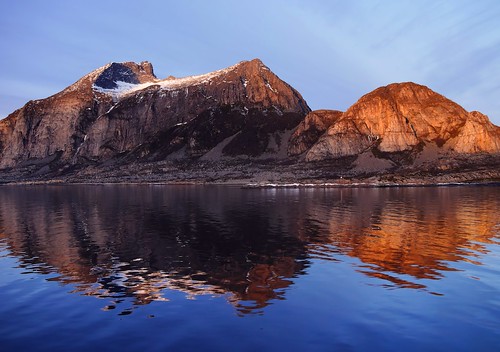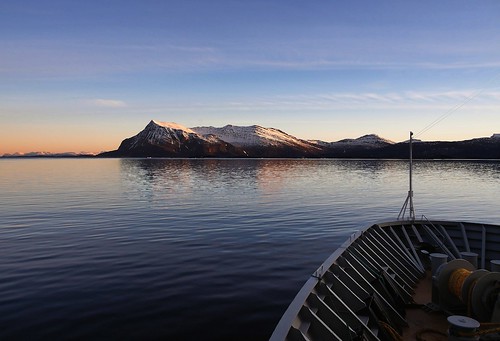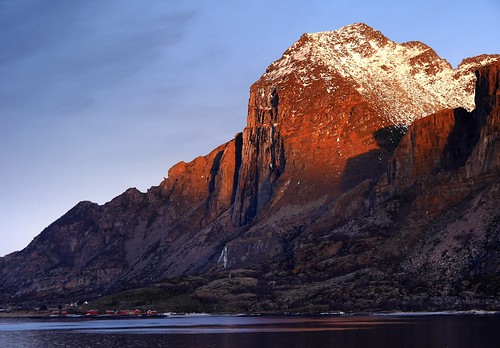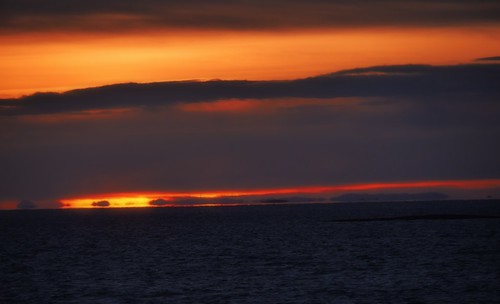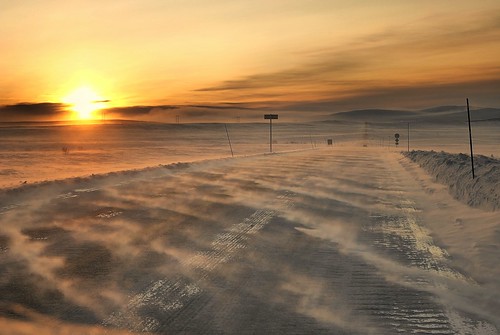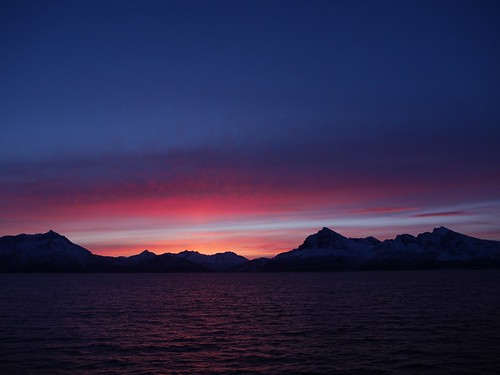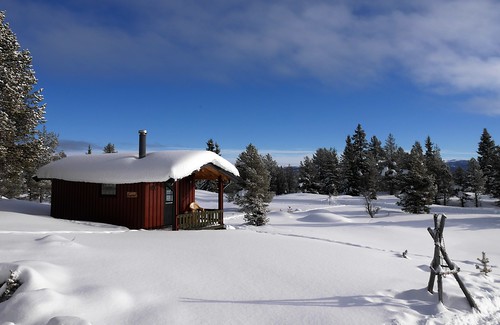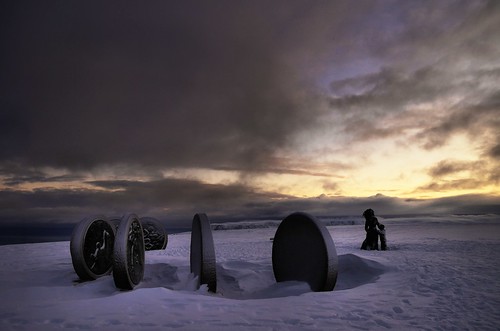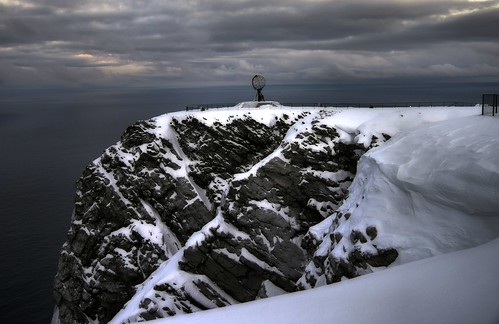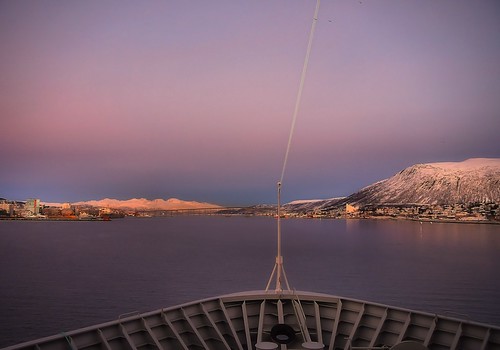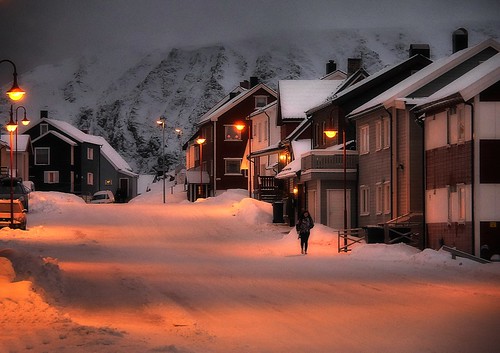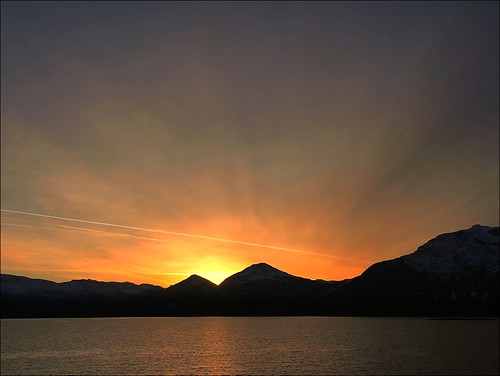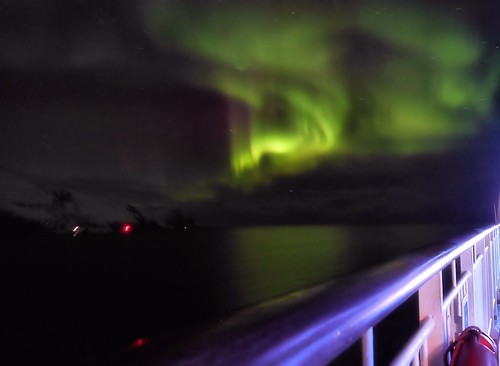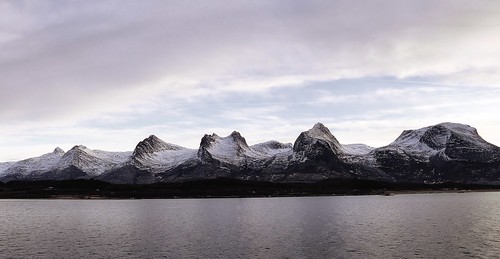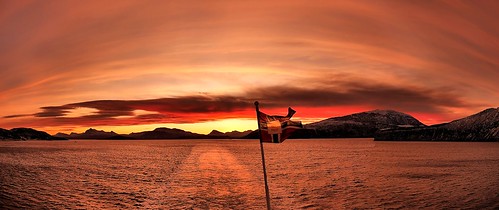February 28, 2014
Norway Arctic - passing 1 of our 50000 Islands along the coast
February 27, 2014
Norway Arctic: Sailing with MS Midnatsol
February 26, 2014
Norway Arctic - the places we live
February 25, 2014
Norway - layered sunset in January
Tour to Norway, North Cape. Day 02 - Layered Fjord Sunset
I left the central town of mid Norway, Trondheim, at noon with the coastal express MS Midnatsol.
I am sailing out the Trondheimsfjorden on my way North. At 3.40 PM the sun is setting partly hidden by some low clouds drifting over the sea out there.
From the net:
The Trondheimsfjord an inlet of the Norwegian Sea, is Norway's third longest fjord at 130 kilometres (81 mi) long. It is located in the west central part of the country, and it stretches from Ørland in west to Steinkjer in north, passing the city of Trondheim on its way.
Its maximum depth is 617 metres (2,024 ft), just inside of Agdenes.
The largest islands in the fjord are Ytterøy and Tautra; the small Munkholmen is located near the harbor of Trondheim; and there are several islands at the entrance of the fjord.
February 24, 2014
Norway Arctic: Where is the European highway E6?
February 23, 2014
Norway Arctic - A Lumix GX7 photo
Tour to Norway, North Cape. Day 04 North of Harstad
As you may have noted I did this tour using my new, mirrorless system camera: Panasonic Lumix GX7.
My 4:3 lens is an Olympus M. Zuiko Digital ED 14-150mm (35mm equal= 28-300mm), F4.05.6. (Why I made a choice for the Olympus lens was purely a price question as the equal Lumix lens was considerably more expensive.
Combined with the fact that the main difference, according to some tests, was that the Panasonic had a lens stabilizer which Olympus did not have. On the other hand the new camera have a camera stabilizer build in the house so no big deal.)
After being a Nikon fan through many DSLR years (even before that with the traditional SLR cameras), and then a short period with Canons top compact camera the Canon G1X, I was very impressed reading some tests on my present Panasonic Lumix GX7 mirrorless system camera (comes even with a super electronic viewfinder) - and ended up with the gear as mentioned above.
As an example of the result you can have right out of the RAW file I present this photo taken in the incredible light in north of the Arctic Circle where the sun in January, in the middle of the dark winter, was rising (under my tour) around 9.30AM and was setting around 2.30PM. Some variations depending on how far north I was at the different days.
Today I present you with a jpg version that is totally without any PP Process from the RAW file - that is except for reformatting from 4592x3448 pixels to 1065x800 pixels (click the photo).
(My usually PP process for the photos used in this series is: Cropping, digital noise removal (ev. Classical soft focus), sharpening and adjustment of levels (or curves) (light and contrast). (But as mentioned in this photo only resizing.)
The photo is taken 9.26AM at sunrise, Jan, 22. 2014. According to my sailing plan with the coastal express we was at that time app. at 68 degrees North (a bit north of Harstad) which we departed 8.00AM).
(Are you in any need to see the full size photo - contact me.).February 22, 2014
Winter holidays in Norway
Our small "guest house" was again in use at our mountain place this week as we had some days off for our traditional "winter holiday".
February 14, 2014
North Cape, Norway - Children of the World
On Tour to North Cape - day 06 - Finally there III
To be found at the North Cape by the tourist Center: The "Children of the world" sculpture created by Seven children from Thailand to Tanzania.
Here photographed at a visit a grey day in January.
It was strange being almost alone around this great sculpture partly covered in snow in a very low light environment - still with a fading sun in the clouded sky.
And I think this photo version of the sculpture on this day for me was a small highlight as I walked around in solitude at North Cape - outside and inside the big North Cape center.
(BTW the blue in the snow is due to the Arctic low light winter season not any idea, wish or PP from my side :-))
From the net:
The “Children of the World” sculpture was started in 1988 when author Simon Flem Devold randomly selected seven children from seven countries – Tanzania, Brazil, USA, Japan, Thailand, Italy and Russia — to visit the North Cape to dream of “Peace on Earth”.
During their seven day visit, each of the 8-to12-year-old children made a clay relief symbolizing friendship, hope, joy and working together. In 1989 the reliefs were enlarged, case in bronze and erected in a semi-circle outside the North Cape Hall. A “Mother and Child “monument by sculptor Eva Rybakken points toward the seven disks.
February 13, 2014
Tour to North Cape, Norway. Day 06 - finally there II
February 12, 2014
Norway: Arctic landscape - day 05
On the Coastal steamer MS MIdnatsol on tour to my final destination Honningsvaag and North Cape
In the short time between sunrise and sunset the low light present the landscape in a fine way with good details on the clouded day.
Some Norway info from the net:
Norway has a very elongated shape, one of the longest and most rugged coastlines in the world, and some 50,000 islands off the extremely indented coastline. The mainland covers 13° latitude, from 58°N to more than 71°N, (Svalbard north to 81°N), and covers the longitude from 5°E in Solund to 31°E in Vardø (Jan Mayen to 9°W, Kvitøya to 33°E).
Norway is one of the world's most northerly countries, and one of Europe's most mountainous countries with large areas dominated by the Scandinavian Mountains; average elevation is 460 m and 32% of the mainland is located above the tree line.
Virtually the entire country was covered with a thick ice sheet during the last ice age, as well as in many earlier ice ages. The movement of the ice carved out deep valleys, and when the ice melted, the sea filled many of these valleys, creating Norway's famous fjords.February 11, 2014
Tour to Norway North Cape. Day 04 - arrival in Tromsoe
Tour to Norway, North Cape. Day 04 Arriving with the Coastal Express MS Midnatsol to Tromsø
The largest town in Norway Arctic is coming up in front of the ship as we, in the artic afternoon light, sails towards the harbour which will be at the left side of the bridge in the far distant. To the right you can see the Arctic Cathedral with the typical white walls.
From the net_
Tromsø city is the ninth-largest urban area in Norway by population, and the seventh largest city in Norway by population. It is the largest city and the largest urban area in Northern Norway, and the second largest city and urban area north of the Arctic Circle (following Murmansk).
Most of Tromsø, including the city centre, is located on the small island of Tromsøya in the county of Troms, 350 kilometres (217 mi) north of the Arctic Circle. Substantial parts of the urban area are also situated on the mainland to the east, and on parts of Kvaløya—a large island to the west. Tromsøya is connected to the mainland by the Tromsø Bridge and the Tromsøysund Tunnel
The city is warmer than most other places located on the same latitude, due to the warming effect of the Gulf Stream.
The city centre of Tromsø contains the highest number of old wooden houses in Northern Norway, the oldest house dating from 1789. The Arctic Cathedral, a modern church from 1965, is probably the most famous landmark in Tromsø.
February 9, 2014
Norway - Arctic landscape
Tour Norway Arctic. Day 10 onboard the coastal express MS Nordkapp
Landscape seen from hurtigruten, the coastal express, after leaving the town Harstad on our way South. This is a panorama made of 4 photos stitched as the sun have started to rise at app 9.20AM.
Note that there seem to be less snow here than we had further North.February 8, 2014
Norway North - Honningsvaag: Saturday in a Fishermans village
Tour to North Cape. Day 05 Honningsvaag/North Cape
A Saturday at 2 pm in January. A street in suburban Honningsvaag - a small fisherman's village only some 30km from North Cape - the most northern point on the European mainland (to be found at 71 DEG NORTH).
The sea was probably the main food source.
February 7, 2014
Norway - early afternoon Aurora Borealis?
Tour to North Cape - day 4
Tour to North Cape, day 04 - Strange arctic light
So early in the afternoon that with your eye it was almost invisible this (supposed) Northern Light - Aurora Borealis.
Sitting by the PC doing some PP on my photo software a complete transmission unfolded to this beautiful (supposed) aurora. I had to increase the contrast and use levels to alter/lower the amount of light in the photo.
Aperture at F/6.4, shutter at 1/200 and ISO 200.
The photo is shot at noon in originally the twilight time so far north this day in January.
When you look at the Northern Light with your eyes it often looks just like a green cloud - while the more significant patterns is more focused from a camera where you shoot with extended shutter times as compared to the version used here.
Anyway I can not tell if it is or not an early rendering of the Aurora Borealis - but it was for sure a strange light to be an "ordinaire" cloud.....
February 6, 2014
Norway: Arctic sunrise at 10:30
TOUR to North Cape, day 03
As I go steady North with the coastal express Hurtigruten we have passed the arctic circle and is someplace south of Bodø when the sun is to rise behind some low islands. The time is 10:30 - and just a few days ago you would not sea the sun at all.
As I left Oslo 3 days ago the days who was starting to become longer down there is up here still considerable shorter in this period of January (as opposite to the midnight sun in the summer)February 5, 2014
Norway, Northern Light - Aurora Borealis
Day 04 on my tour to North Cape Norway
I present today another version of my Northern light - Aurora Borealis photos, shot from the upper deck of Hurtigruten - the coastal express, somewhere a bit south of Tromsø in Norway North.
Some central exif info: F4 Shutter 8sec. ISO 1600. Manual focus.
My lens is an Olympus 14-150mm mounted at my Lumix GX7 mirrorless camera. (35mm equal= 28-300mm). This a top lens for allround shooting but of course have the disadvantage in not being especially light sensitive (F4 is maximum aperture).
Shooting in a pitch dark environment as a arctic night like this, calls for a lens with an opportunity to be more light sensible. Also the mix of ISO speed and shutter time is essential to have a better result than displayed here.
Even in this smaller version from the original I find the ISO noise to be disturbing and also the lens ability to render more light i.e. from the landscape.
Finally shooting with long shuttertime from a ship moving in app. 30km/hrs (some 17 nat. miles) is neither any optimal situation.
Conclusion: Use your best lens -aperture wise-, use a wide angel lens, increase the shutter time and use lowest iso possible (under the excisting conditions) in this "mix" to have a better result. And use manual focus.
Good luck should you have the chance to photograph the Northern Light - Aurora Borealis.February 4, 2014
NORWAY TOUR: Day 12 - Nidaros Cathedral
February 3, 2014
TOUR Norway Arctic - day 11 - The Seven Sisters
Today a 2 photos stitch of this well known mountain range at the coast of Helgeland, Norway. Photographed from the Hurtigruten going South from Sandnessjøen.
From Wikipedia, the free encyclopedia
De syv søstre - The seven sisters - Berge Sieben Schwestern
Country Norway
County Nordland
Range coordinates
65°57′N 12°34′ECoordinates: 65°57′N 12°34′E
De syv søstre (The Seven Sisters) is a mountain range on the island of Alsten in Norway.
The seven peaks are (northeast to southwest):
Botnkrona (1,072 m)
Grytfoten (1,019 m)
Skjæringen (1,037 m)
Tvillingene ("the twins") (945 m and 980 m)
Kvasstinden (1,010 m)
Breitinden (910 m)[2]
The range is popular with hikers and offers scenic views over the surrounding area. On clear days visitors can truly understand why the surroundings are called "The kingdom of the thousand isles" by the local populace.
All the peaks can be climbed using marked paths, and on every summit there is a notebook where visitors can write their name.[3] After visiting all peaks, hikers can contact the local tourist association which will issue a certificate as a testimonial of their achievement. There is no time-limit for climbing all the peaks. The record for the quickest visit to all peaks is under 4 hours.
A good view of the mountain range can be achieved traveling by sea in the "Hurtigruten", as it passes the full length of the range.February 2, 2014
Tour: Norway Arctic - day 10 - Going South
I am standing in the aft of the ship with the camera on my monopod and take those 3 photos to be stitched later.
We are leaving Stomarknes in Vesterålen heading Southeast.
In the aft of the boat, with the post flag up, we can see that the sun have started its setting in the very early afternoon - almost in a tropical matter with regard to the play of warm light in the Arctic waters.
We are still North of the Polar Circle.February 1, 2014
TOUR TO Norway Arctic - day 09 - Lyngen
On my way South I follow the roads around a number of fjords - covered in white in this January.
Mountains shooting 600 to 1200 meters right up from the sea.
Here app 2 hrs. to go to Tromsø - the biggest city up in this part of the country. Take a look at the pano - 3 photos stitched
- using not a tripod but always (these days) a monopod.
